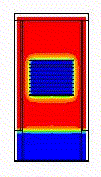
Why simulate CVD?
Simulation is used to improve the design of CVD equipment, to reduce the need for
prototyping and to answer the "what if" questions of engineers. Using the
PHOENICS-CVD software system engineers can:-
- optimize CVD reactor design;
- tune process parameters to improve yield;
- explore new processes before equipment is purchased;
- troubleshoot poorly operating processes and equipment.
PHOENICS-CVD is an integrated software system designed to simulate the behavior of a wide range of CVD reactors; this involves the modeling of fluid flow and heat transfer in a multi-component gas, including both gas-phase (homogeneous) and surface (heterogeneous) chemical reactions and incorporating plasma effects. Implementation is by means of a graphical, menu-driven, object-orientated interface, coupled with a library of generic reactor designs providing an easy route to problem set-up and modification. PHOENICS-CVD offers:
- Simulation of steady-state or transient (process start-up and shut-down) behavior in Cartesian, polar or BFC grids;
- Multi-component diffusion and gas properties with a choice of models;
- Thermal diffusion with a choice of options;
- Gas and surface chemical reactions, with built-in options and the provision for user-coding if required;
- Surface-to-surface radiation;
- Plasma modelling using an effective drift-diffusion model;
- Data files for transport, thermodynamic, material, optical and chemical reaction parameters;
- Platform independence: ability to run on PCs (MS Windows/LINUX), workstations (UNIX and VAX) and supercomputers.
Application examples
PHOENICS-CVD has been used to simulate:-
Silicon nitride formation in a hot wall batch reactor;
PHOENICS-CVD has been validated for a range of CVD processes. The development and experimental verification of PHOENICS-CVD are documented in over 20 publications; copies are available from CHAM.
Links
For further information about PHOENICS-CVD, licence arrangements, consultancy, seminars and courses, and more specifically what it can do for you, contact CHAM.